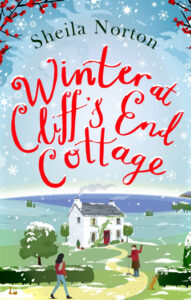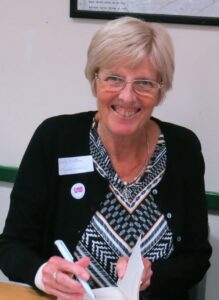Sheila Norton – Winter At Cliff’s End Cottage
6 December 2021
 We are delighted to welcome Sheila Norton to the blog to talk about her new novel, Winter at Cliff’s End Cottage, just in time for the holiday season. Sheila, tell us a little about your book. Where did your inspiration come from?
We are delighted to welcome Sheila Norton to the blog to talk about her new novel, Winter at Cliff’s End Cottage, just in time for the holiday season. Sheila, tell us a little about your book. Where did your inspiration come from?
Living part-time near the Devon coast as I now do, I became fascinated by the idea of coastal erosion and people whose houses are at risk of being lost to the sea. I had a picture of Cliff’s End Cottage in my mind as I began to plan the story, and a picture of Stella, the elderly protagonist, who lived alone and was stubborn about staying in her house. I wanted her to tell her life story, so it was easy to decide on a younger protagonist who had good reason for wanting to hear it – a journalist!
Many of your books feature animal co-stars, and Winter at Cliff’s End Cottage is no exception. (I notice there are cats living on that cliff!) What attracts you to pets in literature?
Well, I’ve lived with dogs, cats, or both during most of my married life so I do think they’re interesting and add something to a story. But strangely enough, it was my previous publisher that got me started on ‘pet lit’, by commissioning me to write two stories narrated by cats! (Oliver the Cat Who Saved Christmas and Charlie, the Kitten who Saved a Life) – and I realised from this, just how many people love stories that include pets. The pets in my stories now are secondary characters, but I still love to include them; they can be such fun and have such a variety of characteristics!
What’s your revision process like? How many drafts do you go through before you’re ready to show the work to your agent/editor?
Hm, well, this varies from book to book! I have been known to write a novel straight through and only do a little revision until the editor gets their hands on it. On the other hand, if I find I’m struggling in the early chapters of a story, I’m not above starting over completely (but always saving the original, in case I want to include bits of it once the new version gets going!). On average, I probably do two or three complete re-reads after finishing, each of which will inevitably lead to some changes. I tend to know when the time has come to stop fiddling with it!
 You’ve switched publishers for Winter at Cliff’s End Cottage. Can you tell us a little about what motivated that decision?
You’ve switched publishers for Winter at Cliff’s End Cottage. Can you tell us a little about what motivated that decision?
In fact, the decision was made for me, because Ebury (the branch of Penguin Random House I’d been with for the previous seven novels) decided to stop publishing fiction. So I was left without a publisher, but fortunately my agent Juliet sent out Winter at Cliff’s End Cottage to several publishers and it was accepted by Piatkus (Little Brown). It’s quite serendiptous for me, as Piatkus had published my first eight books, starting in 2003 with The Trouble with Ally. So I’ve come full-circle and it’s nice to be back with them.
I notice you’ve self-published your early books that have gone out-of-print as well as anthologies of your short stories that were previously published in women’s magazines. Can you tell me more about that process?
Yes, I got back the rights to my early books at a good time for self-publishing, just as Kindle books really took off. I was out of contract at the time, so I decided to self-publish with Amazon, as at that time I’d just left the day job and couldn’t afford to pay to self-publish. I was lucky, hitting the right time for the Kindle market and did quite well with them, so I began to write some new books specifically for self-publication on Amazon, and also experimented with two volumes of short stories – all previously published in women’s magazines, during the years before my first novel was accepted. It was an interesting experience, but gradually it became more difficult to stand out in Amazon’s very overcrowded market. So I was glad when the offer came from Ebury to write the cat books – and although I’d definitely never say never, in terms of self-publishing again, I do prefer being with a mainstream publisher.
You mention Winter at Cliff’s End Cottage is your favourite book that you’ve written so far. What makes Winter at Cliff’s End Cottage so special to you?
I fell in love with the two main characters, particularly Stella, who’s had a tough life and (like a lot of elderly people) is so stoical in the face of difficulties! And I enjoyed writing the flashbacks of Stella’s early life. I’ve never been a historical author; the furthest back in history I’ve written before was the 1960s (my own teenage years) for a couple of my self-published books. But I wanted to include some World War Two memories for Stella’s early childhood. Fortunately these didn’t need to be too detailed as she was so young at the time, and I do have early memories of my own, of things like rationing (in the years after the war), so it was interesting to do the research, without it being too onerous! I also loved describing the setting of Cliff’s End Cottage: lonely, cold and perched high on a Devon cliff. Finally, the story is very emotional in parts. It made me cry even while writing it!
Can you tell us anything about your next writing project?
It will be the second book in this contract with Piatkus, and again (as with all my recent books) is set in south Devon, my ‘adopted’ county. It’s probably a bit soon to tell you much, as we all know how much a story can change during the editorial process! But as always, my focus is on my characters and their emotions, with a lot about friendship, a touch of romance, and a quest to find out about the past.
About Winter at Cliff’s End Cottage
Cliff’s End Cottage is a local landmark. Perched on the South Devon coast, its garden has begun slowly toppling into the sea, yet the elderly and infamously stubborn owner Stella refuses to leave her home. When Holly, a young journalist and single mum struggling to make ends meet, decides to interview Stella about her life, at first she’s given short shrift. However, helped by a slice or two of cake and a couple of friendly cats, a tentative friendship begins to develop between the two lonely women.
Stella and Holly may live different lives, but over the cold winter nights, as Stella shares her story, the two women discover more and more in common. Time is running out for the house on the edge, but perhaps, together, Stella and Holly can find a new way forward.
About Sheila Norton
Sheila Norton lives with her husband near Chelmsford in Essex, and part-time near Torquay in Devon. She spent most of her working life as a medical secretary, before retiring in 2008 to concentrate on her writing. During the years she spent bringing up her three daughters, she took various jobs including teaching the piano and recorder, doing home typing, and working in a playgroup, but always wanted to be an author. She had over one hundred short stories published before the acceptance of her first novel, published in 2003. She now has six grandchildren, and also has two cats – the latest in a succession of dogs and cats who have inspired some of her recent stories! When not working on her writing, Sheila most enjoys spending time with her family and friends, as well as reading, walking, playing the piano, and photography, and loves exploring the contrasting countrysides of Essex and Devon.
Sheila was talking to Victoria Chatfield.
 Victoria Chatfield originally hails from New York where she worked as a social media manager in the fashion industry. While she started out as a ghostwriter for magazine editors, she’s now a member of the NWS, writing romantic suspense and psychological thrillers. (She loves the really bad boys.) Find her on Facebook and Twitter at @vavazquezwrites.
Victoria Chatfield originally hails from New York where she worked as a social media manager in the fashion industry. While she started out as a ghostwriter for magazine editors, she’s now a member of the NWS, writing romantic suspense and psychological thrillers. (She loves the really bad boys.) Find her on Facebook and Twitter at @vavazquezwrites.



